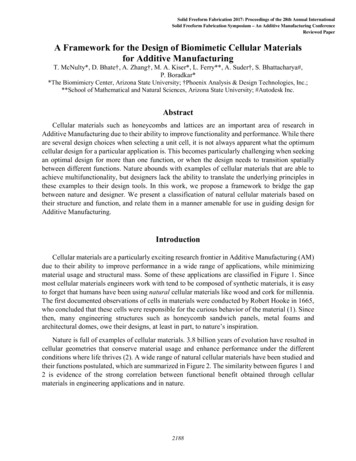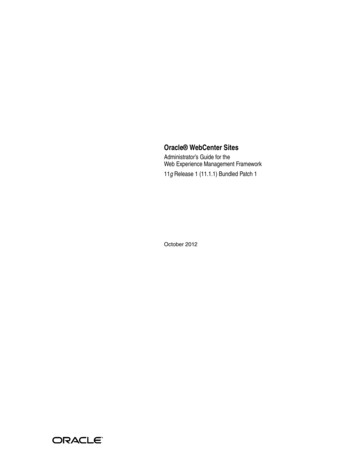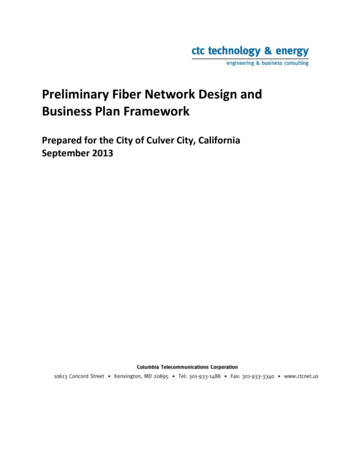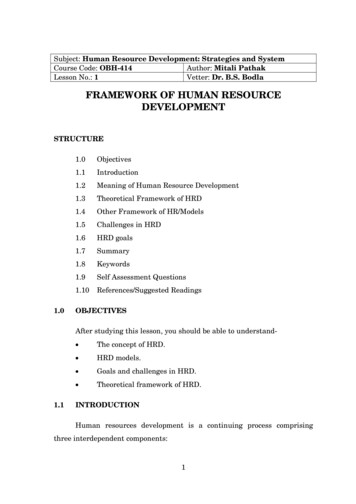
Transcription
Solid Freeform Fabrication 2017: Proceedings of the 28th Annual InternationalSolid Freeform Fabrication Symposium – An Additive Manufacturing ConferenceReviewed PaperA Framework for the Design of Biomimetic Cellular Materialsfor Additive ManufacturingT. McNulty*, D. Bhate†, A. Zhang†, M. A. Kiser*, L. Ferry**, A. Suder†, S. Bhattacharya#,P. Boradkar**The Biomimicry Center, Arizona State University; †Phoenix Analysis & Design Technologies, Inc.;**School of Mathematical and Natural Sciences, Arizona State University; #Autodesk Inc.AbstractCellular materials such as honeycombs and lattices are an important area of research inAdditive Manufacturing due to their ability to improve functionality and performance. While thereare several design choices when selecting a unit cell, it is not always apparent what the optimumcellular design for a particular application is. This becomes particularly challenging when seekingan optimal design for more than one function, or when the design needs to transition spatiallybetween different functions. Nature abounds with examples of cellular materials that are able toachieve multifunctionality, but designers lack the ability to translate the underlying principles inthese examples to their design tools. In this work, we propose a framework to bridge the gapbetween nature and designer. We present a classification of natural cellular materials based ontheir structure and function, and relate them in a manner amenable for use in guiding design forAdditive Manufacturing.IntroductionCellular materials are a particularly exciting research frontier in Additive Manufacturing (AM)due to their ability to improve performance in a wide range of applications, while minimizingmaterial usage and structural mass. Some of these applications are classified in Figure 1. Sincemost cellular materials engineers work with tend to be composed of synthetic materials, it is easyto forget that humans have been using natural cellular materials like wood and cork for millennia.The first documented observations of cells in materials were conducted by Robert Hooke in 1665,who concluded that these cells were responsible for the curious behavior of the material (1). Sincethen, many engineering structures such as honeycomb sandwich panels, metal foams andarchitectural domes, owe their designs, at least in part, to nature’s inspiration.Nature is full of examples of cellular materials. 3.8 billion years of evolution have resulted incellular geometries that conserve material usage and enhance performance under the differentconditions where life thrives (2). A wide range of natural cellular materials have been studied andtheir functions postulated, which are summarized in Figure 2. The similarity between figures 1 and2 is evidence of the strong correlation between functional benefit obtained through cellularmaterials in engineering applications and in nature.2188
CoresFlameArrestersPackagingCell VibrationControlFigure 1. Application areas for cellular structures in engineering solutions that can leverage their specialproperties to enhance overall functional performance, adapted from (3)Figure 2. Classification of functions of cellular structures in nature, adapted from (1)2189
Recent advances in software have made it feasible to design structures that incorporate intricatecellular structures and AM technologies have enabled these designs to be realized. However, it isnot always apparent to the designer which cellular geometry is ideal for a specific function. Thisbecomes particularly challenging when designing for multiple functional objectives. It is thischallenge that we seek to address by using a biomimetic approach to help a designer select anappropriate cellular structure for a specific function and integrate it into a larger structure. Wepropose a four-level framework to integrate this biomimetic approach into an overall design andmanufacturing strategy, as shown in Figure 3.Figure 3. Proposed framework for implementing a biomimetic approach in the design and manufacturingof parts with cellular materialsIn this paper, we seek to develop the top level of this framework. We first review themethodology we used to discover natural models (i.e. species in nature), and how this selectionwas narrowed in scope. Next, we present a set of candidate natural cellular design structures thatwe discovered, followed by a classification of these structures and the load-bearing functions thatare of relevance to the design of engineering structures. Finally, we discuss limitations of thisapproach.MethodologyWhile the use of biomimicry to address problems and uncover opportunities is not new, it isonly more recently that a methodology for applying the subject systematically has emerged (2).The methodology can be used in two different ways: in the first approach, the solution to a specificchallenge is sought in nature (“Challenge to Biology”). In the second approach, a study of the2190
biological organism(s) leads the way to inspiring designs (“Biology to Design”). For this work, weused the first approach, but with the specific intent of finding examples of cellular materials innature that manage structural forces effectively. With this approach, multiple design principleswill emerge together to inform the design space. For our purposes, we define ‘cellular’ materialsas those materials with a specific, repeating structure that forms the basis of the material itself. Thespecific steps we used in this work are as follows:1. The “Challenge to Biology” approach enables the discovery of natural models which arerelevant to our functional needs within contextual considerations. Through a wide surveyof the available literature, we identified approximately 70 different natural models thatwere constructed at least partially of cellular materials, ranging from the well-known bee’shoneycomb to the Venus’ flower basket, a sea sponge that has a crack-arresting hierarchicallattice structure.2. Having identified these models, we studied and vetted our selection in the literature againstthe function and context of interest to establish the nature of the cellular material (designstrategy), as well as evidence of a functional basis for the structure in question (i.e., thefunction of the material was for providing support to the structure). In some cases this wasa hypothesis bolstered with circumstantial observations, in others the structure’sfunctionality was validated through experimental or numerical techniques. Some naturalmodels were discarded from consideration since the causality between structure andfunction could not be robustly identified.3. Finally, we narrowed the scope to examining how these specific cellular design strategiesresponded to, and managed, imposed loads. This is a non-trivial aspect of the work sincemany natural cellular models have arisen (over evolutionary time) for more than onefunction, and a sub-optimal solution for managing forces may exist a trade-off for anotherfunction, such as buoyancy or thermal management.Natural Cellular Design StrategiesOur study of cellular materials in nature resulted in the identification of 11 models for whichwe identified adequate evidence of a causal link between observed structure and function, andfurther that this function was of a structural (load-bearing) nature. In our study, it emerged thatcellular materials in nature could be broadly classified as being used to either fill space (3D),develop surfaces (2D) for protection, or use cellular design in cylindrical structures. These threecategories align well with engineering structure design. We discuss these natural models for eachof these three categories in turn.1. 3D Space-Filling StructuresThe most significant driver for the use of cellular materials with AM is their potential to reducematerial usage and mass – this is critical for aerospace applications but also relevant for the widertransportation sector as well as for the biomedical and construction fields. Mass reduction is mosteffective when it is applied to as much of the structure in question, and is thus relevant fordesigning 3D space-filling structures.2191
Nature often seeks to minimize costly material usage, which has been described as one of“life’s principles” (2). The specific strategy for minimizing mass for a particular organism is afunction of the specific loading conditions the structure is aiming to withstand, which in turn isinfluenced by the context the structure is experiencing. In Table 1, we list 3 different examples of3D space-filling with cellular materials in nature, along with references that discuss the biologicalbasis for the structure in greater detail than is in scope for this discussion.Table 1. Space-filling (3D) cellular materials in nature#Organism / OrganiHoney Bee Nest (Apis)iiVenus Flower Basket(Euplectella aspergillum)iiiCellular MaterialRepresentationDesignStrategies &PrinciplesTransverselyisotropic anduniformhexagonalcolumns (1) (4)AttributedStructuralBenefitHigh specificstiffness underself-weight (1)Enclosed lattice Resilience tostruts (5)hydrostatic(compression)forces (5)Toucan Beak (Ramphastidae)Hierarchicalstructure (6) (7)Crack growtharresting (6)Lattice struts &closed cellfoam (8)High flexural(bending) stiffness(8)Image Attributions:i.Honeycomb: public domain, no attribution available or neededii.Venus’ Flower Basket: NOAA Okeanos Explorer Program, Gulf of Mexico 2012 Expeditioniii.Toucan: By Nicolas Billebault, via Wikimedia Commons2. Surface (2D) StructuresSeveral engineering structures involve enclosing an entity in an external surface. These span arange of scales from spacecraft and submersible hulls to aerodynamic skinsuits for cyclists. Inkeeping with the overall scope of this paper, we limit ourselves here to the discussion of surfacestructures that excel at managing mechanical loads and have identified a few organisms in Table2 that achieve this through different strategies.2192
Table 2. Surface (2D) cellular materials in nature#Organism / OrganiAmazon Waterlily leafunderside (Victoria amazonica)iiCellular MaterialRepresentationDesignStrategies ness (9)(10)Pomelo skin (Citrus maxim)Open-cellfoam (11)(12)Impactresistance (11)(12)iiiElasmobranchii skeleton (13)Bendingflexibility (14)ivRed Abalone shell ndwich(15)Fracturetoughness undertension (16)vMantis Shrimp club(Stomatopod)HelicaltrussesImpactresistance (17)Nanoparticlecoating(17)Image Attributionsi. Amazon Waterlily: By Jojona, via Wikimedia Commonsii. Pomelo: Allen Timothy Chang Starr, Forest & Kim Starr derivative work via Wikimedia Commonsiii. Elasmobranchii: Dean Mason (rights reserved), modified from Seidel et al. (13)iv. Red Abalone: By Merlin Charon, via Wikimedia Commonsv. Mantis Shrimp: By Silke Baron, via Wikimedia Commons2193
3. Cylindrical StructuresIn addition to using cellular materials in constructing space-filling structures and surfaces,nature also leverages these materials for cylindrical structures, examples of which are shown inTable 3.Table 3. Examples of cellular materials in cylindrical structures#Organism / Organ1Balsa trunk and branches(Ochroma pyramidale)Cellular MaterialRepresentationDesignStrategies &PrinciplesVerticalhexagonalcolumns (1)AttributedStructuralBenefitHigh stiffnessunder tensionand shear (18)Strength undercompression(19)23Hedgehog quill (Erinaceinae)Banana petiole (Musa textilis)Stiffeners (1)Bending,ovalization andbucklingresistance artitions(21)Torsionalflexibility (21)Image Attributions1. Balsa Wood: Gabriele Kothe-Heinrich, via Wikimedia Commons2. Hedgehog: By Lars Karlsson (Keqs), via Wikimedia Commons3. Banana: public domain, no attribution available or requiredWhile many cylindrical structures in nature such as plant stems, serve a transport function,they are nonetheless also structured to resist bending, ovalization and buckling. As shown in Figure4, these has led to a range of strategies for adding cellular designs within cylindrical structures toachieve these benefits.Figure 4. Design strategies for improving bending, ovalization and buckling resistance in cylindricalstructures found in animal quills and plant stems, adapted from (20)2194
Biomimetic Cellular Materials DesignThe main objective of this work is to propose a framework for the design of biomimetic cellularmaterials that can be integrated into the larger design and manufacturing system proposed in Figure3. Towards this end, we need to identify the underlying patterns emerging from our biologicalmodels by using classifications that allow us to explore both the design options and the functionalrequirements. Finally, we need a framework that associates design and function to guide selectionof a specific cellular design for a larger component. We deal with each of these three aspects inturn.1. Classification of Design OptionsThere are several ways to classify cellular materials (22; 23; 3). In the context of the presentwork, we take our cues from nature and propose a separation based primarily upon the use of thematerial for either 2D (surface) or 3D (space-filling) purposes, while also identifying strategiesthat cut across both approaches. This classification is compiled in Figure 5, with self-explanatoryrepresentations of the associated geometry.Figure 5. Proposed classification for cellular material designs, grouped in terms of 3D and 2D and crosscutting concepts that apply to all cellular designs2195
2. Classification of Functions (Load-bearing)Natural and manmade structures both perform one, or more, functions in a larger system. Morefundamentally, however, a structure defines form and must have properties that enable it to retainthis form while meeting functional requirements in its environment for the duration of its usefullife. In engineering structures, the most important properties of interest are stiffness (or rigidity;the ability to resist permanent deformation), strength (the ability to resist buckling) and toughness(the ability to resist fracture). These properties are defined in context of the conditions experiencedby the structure. With regard to the nature of loads, these are typically classified as compression,tension, torsion, bending and shear, or some combination of these (24). Further, these loads maybe applied in one or many directions (such as uniaxial, biaxial and hydrostatic) and with differentdurations (such as varying strain rates, fatigue and vibration). Thus, the loading condition can beadequately described by specifying three pieces of information (see Figure 6):1. Loading type2. Loading direction, and3. Period of application(a)(b)(c)Figure 6. Proposed classification for loading conditions: (a) Loading type, (b) loading direction and (c)period of application2196
3. Structure-Function RelationshipsWith the classification established for both cellular material design and load-bearing functions,the final step in developing a usable framework is to relate the two. In Table 4, we relate thefunction to the structure, which forms the basis of a design recommendation which we makelimited to the organisms we identified in Tables 1-3.Table 4. Structure-function design guidelinesSpace-Filling (3D)FunctionLoadingLoadingTypeDirectionTension Multi-axialPeriod ofApplicationStaticDynamic,FatigueImpactCellular DesignHexagonalhoneycombEnclosed latticestrutsMix of open andclosed cell foamStructureAdditional DesignConceptsAlign plane of loadingalong isotropic plane ofhoneycombHierarchy to improvefracture toughnessStiffness and energyabsorption cooptimizedSurface lMulti-axialCompression UniaxialCylindrical lStructurePeriod ofCellular DesignAdditional DesignApplicationConceptsStatic,VeiningVein thickness perDynamicMurray’s Law (25)ImpactOpen cell foamFatigueTessellationComposite sandwichStatic, High TessellationComposite sandwichStrain RateImpactHelical trussesNanoparticle coatingPeriod uctureCellular DesignAdditional DesignConceptsHollow Addition of transversestiffenersRemoval of centralunstressed core
ConsiderationsThe key research objective sought in this work has been to assess the feasibility of developinga framework to guide the design of cellular materials for use in parts to be manufactured usingadditive manufacturing. We have attempted to synthesize principles from several different naturalmodels and while we have demonstrated that much is to be gained from such an approach, it isimportant to stress a few considerations that need addressing prior to implementation in designand manufacturing.1. Uniquely Biological ConsiderationsA key challenge faced by living organisms is the need to grow, and in several cases, themaintenance of function during growth (24). It is feasible that a specific structure is sub-optimalfor a specific engineering application since it was constrained by this need. Another challenge withthe biomimetic method is the de-confounding of the functional basis for structure since naturalstructures are often compromises for more than one (sometimes competing) function(s), andidentification of the “weights” of optimization for these objectives is non-trivial. In some cases,the effects of evolutionary baggage also result in sub-optimal design, where features are retainedthrough evolution despite their inadequacies since they either have low inherent costs, or it wasless expensive to make a particular compromise: the giraffe’s convoluted Recurrent LaryngealNerve (RLN) is one such example (26). This highlights the importance of extracting underlyingprinciples, as we have sought to do here, rather than emphasizing one-off discoveries.2. Additive Manufacturing ConstraintsWhile AM processes greatly expand the possibilities for manufacturing parts with cellularmaterials, they do have additional constraints (i.e., ‘design rules’) that limit the selection of cellularmaterial designs. These constraints include: Smallest feature size attainable (typically in the hundreds of microns for most productionscale machines) Largest overhang in lattice-like cellular materials Need for support in most processes, which constrains the cellular design to be selfsupporting Need for removing trapped powder, in powder bed processes, constraining the smallestsize of voids possible in 3D structuresThese constraints need to be fully comprehended prior to the selection of a cellular material design.3. Hierarchy, Gradients and Multi-MaterialsCellular materials are just one of many design strategies found in nature (23). Cellular materialsthemselves consist of multiple materials such as the examples of the abalone shell and mantisshrimp club discussed previously, which currently still poses a challenge for functional partadditive manufacturing. Additionally, cellular materials often have functional gradients or ahierarchy of structure at varying scales, several of which may be below the ability of AM processesto resolve. Nonetheless, as AM technologies improve, it is likely that an increasing number ofbiomimetic designs are rendered feasible.2198
ConclusionsIn this paper, we have demonstrated how a biomimetic approach can be used to enable theselection of cellular material designs for structural load-bearing applications. Our work has led usto draw the following conclusions: Employing the biomimicry methodology of scoping and discovering complimentarymodels allows for a “Challenge to Biology” approach to identifying biological structuresof interestNature tends to employ cellular materials in structural applications in three categories thatalign well with engineering design thinking: space-filling (3D), surface (2D) orcylindrical structuresNatural models tend to demonstrate hierarchy and the use of multiple materials, alongwith cellular material designs to achieve a specific performanceDefining a classification for cellular material structure and load-conditions, as we havedone here, enables the formulation of a structure-function relationship that is the first stepto developing an integrated framework for designing biomimetic cellular structuresIn ongoing and future work, we are seeking to use computational simulation to validate thesebiomimetic design concepts, which is a key step in developing a quantifiable correlation betweenstructure and performance. This in turn, has the potential to unlock the ability to enable truemultifunctional cellular materials design.References1. L. Gibson, M. Ashby, B. Harley. Cellular Materials in Nature and Medicine. s.l. : CambridgeUniversity Press, 2010, 1st Edition.2. Baumeister, D. Biomimicry resource handbook: a seed bank of best practices. Missoula, MT :Biomimicry 3.8, 2014.3. Ashby, Evans, Fleck, Gibson, Hutchinson, Wadley. Metal Foams: A Design Guide. s.l. :Butterworth-Heinemann, 2000, 1st Edition.4. Bioinspired engineering of honeycomb structure – Using nature to inspire human innovation. Zhang,Qiancheng, et al. 2015, Progress in Materials Science, Vol. 74, pp. 332-400.5. Siliceous spicules and skeleton frameworks in sponges: Origin, diversity, ultrastructural patterns, andbiological functions. Uriz, M., et al. 4, 2003, Microscopy Research and Technique, Vol. 62, pp. 279-299.6. Skeleton of Euplectella sp.: Structural Hierarchy from the Nanoscale to the Macroscale. Aizenberg, J.5732, 2005, Science, Vol. 309, pp. 275-278.7. Hierarchical assembly of the siliceous skeletal lattice of the hexactinellid sponge Euplectellaaspergillum. Weaver, James C., et al. 1, 2007, Journal of Structural Biology, Vol. 158, pp. 93-106.8. The toucan beak: Structure and mechanical response. Seki, Yasuaki, et al. 2006, Materials Scienceand Engineering C, Vol. 26, pp. 1412-1420.2199
9. Victoria regia’s bequest to modern architecture. Nielsen, D. 2010, Design and Nature V, Vol. 13810. Attenborough, D. The Private Life of Plants. s.l. : Princeton University Press; 1st edition, 1995.11. Structure–function relationship of the foam-like pomelo peel (Citrus maxima)—an inspiration for thedevelopment of biomimetic damping materials with high energy dissipation. M Thielen, C N Z Schmitt,S Eckert, T Speck and R Seidel. s.l. : Bioinspiration & Biomimetics, 2013, Vol. 8. 2.12. Pummelos as Concept Generators for Biomimetically Inspired Low Weight Structures with ExcellentDamping Properties. Fischer, Sebastian F., et al. 12, 2010, Advanced Engineering Materials, Vol. 12.13. Ultrastructural and developmental features of the tessellated endoskeleton of elasmobranchs (sharksand rays). Seidel, R., Lyons, K., Blumer, M., Zaslansky, P., Fratzl, P., Weaver, J., & Dean, M. 5,s.l. : Journal of Anatomy, 2016, Vol. 229.14. Mechanics of shark tessellated cartilage [dissertation]. Liu, X. s.l. : ProQuest LLC, 2012.15. Growth and structure in abalone shell. Lin, Albert and Meyers, Marc Andre. 390, 2004, MaterialsScience & Engineering A, pp. 27-41.16. An Experimental Investigation of Deformation and Fracture of Nacre – Mother of Pearl. F.Barthelat, H. D. Espinosa. 3, s.l. : Experimental Mechanics, 2007, Vol. 47.17. Deadly strike mechanism of a mantis shrimp. Patek, S. N., Korff, W. L. and Caldwell, R. L. 6985,2004, Nature, Vol. 428, pp. 819-820.18. Structure–property relations for balsa wood as a function of density: modeling approach. O.Shishkina, S. Lomov, I. Verpoest, L. Gorbatikh. s.l. : Arch Appl Mech, 2014, Vol. 84.19. Compressive response and failure of balsa wood. Silva, Andre Da and Kyriakides, Stelios. 25-26,2007, International Journal of Solids and Structures, Vol. 44, pp. 8685-8717.20. Biomimicking of animal quills and plant stems: natural cylindrical shells with foam cores. G. Karam,L. Gibson. s.l. : Materials Science and Engineering C2, 1994.21. The functional morphology of the petioles of the banana, Musa textilis. Ennos, A.r. 353, 2000,Journal of Experimental Botany, Vol. 51, pp. 2085-2093.22. L. Gibson, M. Ashby. Cellular Solids: Structure and Properties. s.l. : Cambridge University Press,1999 (2nd Edition).23. Structural Design Elements in Biological Materials: Application to Bioinspiration. Naleway, StevenE., et al. 37, 2015, Advanced Materials, Vol. 27, pp. 5455-5476.24. Vogel, S. Cat's Paws and Catapults: Mechanical Worlds of Nature and People. s.l. : W. W. Norton &Company, Inc., 1998.25. The physiological principle of minimum work. I. The vascular system and the cost of blood volume.Murray, C. s.l. : Proc. Natl. Acad. Sci., USA, 1926, Vol. 12.26. Dawkins, R. The Greatest Show on Earth: the evidence for evolution. s.l. : Free Press, 2010, 1stedition.2200
between nature and designer. We present a classification of natural cellular materials based on their structure and function, and relate them in a manner amenable for use in guiding design for Additive Manufacturing. Introduction Cellular materials are a particularly











